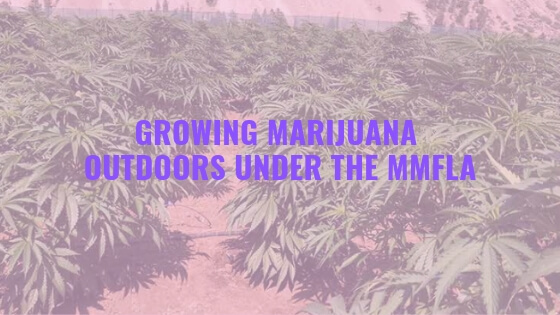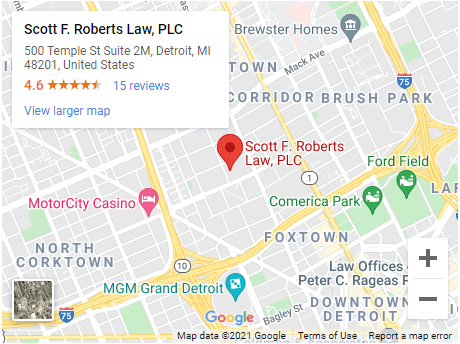Building an indoor cannabis facility is not cheap. In my experience as a cannabis attorney, Medical Marihuana Facilities Licensing Act (“MMFLA”) and Michigan Regulationa and Taxation of Marihuana Act (“MRTMA”) growers will spend anywhere between $100 to $200 per square foot on their interior buildout and equipment. And if you are an MMFLA licensed or MRTMA licensed grower, you will likely have to pay quite the premium just to purchase the underlying cannabis property.
As more and more prequalified cannabis growers are looking to build a licensed marijuana grow facility in Michigan, or are seeking to expand their facilities to include a MRTMA adult-use grower license, building a cost-effective grow facility is not an easy task. Some of the best MMJ grow facilities in Michigan are often quickly snapped up by real estate speculators, sometimes before a municipality decides to even “opt-in” to the MMFLA. As a Michigan cannabis business lawyer, I’ve represented several of these real estate speculators, who use their advanced political knowledge, deep pockets, and even a bit of guess work, to tie up the best Michigan cannabis grow facility properties.
Other indoor marijuana grow facilities can take up to a year or even longer to fully build out. Depending on the state of the building, indoor growers may need to install a new roof, upgrade the building’s electrical system, install brand new HVAC and fire suppression systems, and more. Retrofitting a building for cannabis use can be both expensive and time consuming.
Due to the high price per square foot of MMLFA and MRTMA grow facilities in Michigan—where $100 SF is not uncommon for a decent green-zoned building in the Metro Detroit area, some Michigan growers have decided to seek out an alternative that is both significantly less costly and quicker to market. For some, this means a greenhouse, where lower end models can be built for as little as $40 / SF, though even these involve significant build out, equipment and utility costs. Not to mention, the quality of greenhouse grown medical marijuana is generally not seen as up to par with other indoor growing, making it harder to sell directly to MMFLA provisioning centers and MRTMA retailers.
There is another, often overlooked, option that allows for much less expensive build out, equipment and maintenance costs—outdoor growing. Growing cannabis outdoors in Michigan eliminates the need for a lot of costly equipment, eliminates the need to pay six or even seven figure annual utility bills, and eliminates the need for purchasing buildings at $100+ SF. It can also produce much higher yields, which means less time and effort and more bang for your buck. For these reasons, commercial outdoor cannabis farms are popping up throughout the state.
The Market for Michigan Outdoor Cannabis
There are some downsides to growing medical and adult-use marijuana outdoors in Michigan. The first and most obvious is that it gets pretty cold here in the winter, and our climate does not support a winter crop. Thus, while your yields and marijuana plants can be much bigger during the grow seasons, they are non-existent come January and February. The second downside is quality. Greenhouses suffer a similar weakness, but not nearly to the same extent as pure outdoor cannabis. As medical marijuana patients become more “sophisticated” when purchasing marijuana, and recreational purchasers all wanting “the best stuff”, the direct to consumer market for mid to low quality marijuana isn’t strong.
But there is one cannabis sub-market that is growing faster than most imagined possible—extracts, processed goods, and edibles. When making processed marijuana products, you don’t need the “best” marijuana flower. In fact, a lot of processed cannabis goods are made from the trim of the marijuana plant, though trim often makes for poor quality extracts. Inexpensively grown outdoor cannabis is the perfect input for processed goods, and processed goods are quickly taking over the Michigan market. In more developed recreational states, processed marijuana products make up more than half of all sales, and this number is rising quickly.
Growing Outdoors in Michigan: MMMA, MMFLA, and MRTMA
Whether an outdoor MMJ facility is allowed in the municipality where you want to locate your licensed MMFLA or MRTMA facility depends on that location’s municipal ordinance. Under the MMFLA and MRTMA, it is up to each local unit of government to decide whether to allow marijuana growing in the municipality, and what restrictions, if any, to put on these MRTMA and MMFLA-compliant facilities. That means that it is up totally up to each municipality to decide whether to allow outdoor commercial cannabis grows.
The MMFLA is not like the Michigan Medical Marihuana Act (MMMA) in this respect. The MMMA allows registered patients and caregivers to grow a limited number of plants outdoors, regardless of the municipality, provided that they meet the following requirements:
- not be visible to the unaided eye from an adjacent property when viewed by an individual at ground level or from a permanent structure;
- be grown within a stationary structure that is enclosed on all sides, except for the base, by chain-link fencing, wooden slats, or a similar material that prevents access by the general public and that is anchored, attached, or affixed to the ground;
- be located on land that is owned, leased, or rented by either the registered qualifying patient or a person designated through the departmental registration process as the primary caregiver for the registered qualifying patient or patients for whom the marijuana plants are grown; and,
- be equipped with functioning locks or other security devices that restrict access to only the registered qualifying patient or the registered primary caregiver who owns, leases, or rents the property on which the structure is located.
This is because the MMMA is a broadly applicable state law that preempts any local ordinance in conflict with it, while both the MMFLA and MRTMA leave it up to each local unit of government to decide what type of facilities to allow, how many of each type of facility to allow, and what additional requirements each municipal applicant must meet. The MMFLA and MRTMA gives broad authority to each locality, except that a local government cannot enact regulations on the price or purity of marijuana or otherwise contradict the state law.
So where and how can I grow outdoors in Michigan?
On the state level, the rules that outdoor commercial marijuana grows must meet are minimal. One rule affecting outdoor MMFLA grow facilities is the requirement that any grow facility must be located in an area zoned as industrial, agricultural, or unzoned. This same requirement is not present in the MRTMA, however. Another restriction present in both the MMFLA and MRTMA is the requirement that there be a building adjacent to the cultivation area where drying, trimming and curing must take place. Other than that, and the requirement that the area must be fenced in and not visible to the public, the state-level restrictions are minimal.
The number of cities and townships in Michigan that allow outdoor commercial cannabis cultivation under the MMFLA and MRTMA is growing, though the overall number is still somewhat limited. Even then, most of these municipalities impose additional land use requirements as well as additional restrictions on the outdoor grow facility. The municipal restrictions applicable to grows mostly fall into one of three categories. The first is setbacks—most municipalities that allow outdoor grows that we reviewed require that the outdoor facility be set back from the property lines—some only as little as 20 to 30 feet, others as much as several hundred feet.
The second type of municipal restriction is lot size. Many municipalities require that the outdoor medical marijuana facility sit on property of at least one acre, and sometimes as much as five acres. Finally, at least one municipality specifies additional security restrictions over and above the MMFLA and MRTMA regulations, including requirements that the property be enclosed by fences at least eight feet high surrounding the entire facility as well as locked gates.
In contrast, if you are growing outdoor cannabis as a caregiver under the MMMA, or a 12-plant personal grow under the MRTMA, you are not limited to the handful of municipalities that authorize commercial outdoor cannabis facilities under the MMFLA or MRTMA. You can grow outdoor plants in pretty much any municipality in the State of Michigan, though you are still subject to the restrictions outlined above.
Takeaway
There are a growing number of opportunities for commercial growers under the MMFLA and MRTMA to have outdoor grow facilities in Michigan. The advantage of outdoor cannabis facilities is that they don’t cost much to start up compared to indoor grows and they primarily feed the fastest growing cannabis sub-market—the market for processed marijuana goods such as edibles and extracts. In addition, while very labor intensive, the overall operational costs are less than growing an equivalent amount of indoor plants due to the significant energy savings. Put another way, sunlight is free, while HPS and LED lights can cost quite a bit in terms of energy costs.
The disadvantages are that they are often only allowed in out-of-the-way places and there is not much direct consumer demand for outdoor cannabis. In California, some cannabis companies have been able to sell outdoor grown cannabis direct to the consumer as prerolls, but California’s weather is also much more conducive to outdoor cannabis cultivation than Michigan’s weather. Outdoor commercial growers in Michigan are therefore mostly limited to selling their product to a licensed processor, or to processing the products themselves in order to create their own cartridges, oils, and edibles.
Not every opportunity is right for everyone, but if you think commercial outdoor growing in Michigan is right for you, contact us today to discuss your options. Our firm represents multiple MMFLA and MRTMA outdoor grow facilities, and can help your cannabis business identify and license Michigan cannabis properties for outdoor growing.
Mr. Roberts is the managing partner of Scott F. Roberts Law, PLC, a boutique business and real estate law firm focused on representing commercial cannabis facilities and real estate companies in Michigan. Mr. Roberts is a Michigan marijuana business lawyer and has spoken at several cannabis conferences and CLE events in Michigan.
Old Publication
As more and more start receiving their Medical Marihuana Facilities Licensing Act (“MMFLA”) pre-qualification, choosing a cost effective grow facility is becoming increasingly difficult. The best MMJ grow facilities in Michigan = are often quickly snapped up by real estate speculators, usually before a municipality decides to even “opt-in” to the MMFLA. As a Michigan cannabis business lawyer , I represent several of these real estate speculators, who use their advanced political knowledge, deep pockets, and even a bit of guess work, to tie up the best Michigan cannabis grow facility properties.
Due to the high price per square foot of medical marijuana grow facilities in Michigan—where $100 SF is common place, some growers have decided to seek out a less costly alternative. For some, this means a greenhouse, which can be built at a cost of roughly $40 / SF, though even these involve significant build out, equipment and utility costs. Not to mention, the quality of greenhouse grown medical marijuana is generally not seen as up to par with other indoor growing, making it harder to sell directly to medical marijuana patients.
There is another, often overlooked, option that allows for much less expensive build out, equipment and maintenance costs—outdoor growing. Growing cannabis outdoors in Michigan eliminates the need for a lot of costly equipment, eliminates the need to pay six or even seven figure annual utility bills, and eliminates the need for purchasing buildings at $100+ SF. It can also produce much higher yields, which means less time and effort and more bang for your buck.
The Market for Michigan Outdoor Cannabis
There are some downsides to growing medical marijuana outdoors in Michigan. The first and most obvious is that it gets pretty cold here in the winter, and our climate does not support a winter crop. Thus, while your yields and plants can be much bigger during the grow seasons, they are non-existent come January or February. The second downside is quality. Greenhouses suffer a similar weakness. As medical marijuana patients become more “sophisticated” when purchasing marijuana, and recreational purchasers all wanting “the best stuff”, the direct to consumer market for mid-quality marijuana isn’t strong.
But there is one cannabis sub-market that is growing faster than most imagined possible—extracts, processed goods, and edibles. When making processed goods, you don’t need the “best” marijuana flower. In fact, a lot of processed cannabis goods are made from the trim of the marijuana plant, though trim often makes for poor quality extracts. Inexpensively grown outdoor medical marijuana is the perfect input for processed goods, and processed goods are quickly taking over the market. In more developed recreational states, they make up more than half of all sales, and this number is rising quickly.
Growing Outdoors in Michigan
Whether an outdoor MMJ facility is allowed in the municipality where you want to locate your licensed MMFLA facility depends on that location’s municipal ordinance. Under the MMFLA, it is up to each local unit of government to decide whether to allow medical marijuana growing in the municipality, and what restrictions, if any, to put on these MMFLA-compliant facilities. That means that it is up totally up to each municipality to decide whether to allow outdoor commercial cannabis grows.

The MMFLA is not like the Michigan Medical Marihuana Act (MMMA) in this respect. The MMMA allows registered patients and caregivers to grow a limited number of plants outdoors, regardless of the municipality, provided that they meet the following requirements:
- not be visible to the unaided eye from an adjacent property when viewed by an individual at ground level or from a permanent structure;
- be grown within a stationary structure that is enclosed on all sides, except for the base, by chain-link fencing, wooden slats, or a similar material that prevents access by the general public and that is anchored, attached, or affixed to the ground;
- be located on land that is owned, leased, or rented by either the registered qualifying patient or a person designated through the departmental registration process as the primary caregiver for the registered qualifying patient or patients for whom the marijuana plants are grown; and,
- be equipped with functioning locks or other security devices that restrict access to only the registered qualifying patient or the registered primary caregiver who owns, leases, or rents the property on which the structure is located.
This is because the MMMA is a broadly applicable state law that preempts any local ordinance in conflict with it, while the MMFLA leaves it up to each local unit of government to decide what type of facilities to allow, how many of each type of facility to allow, and what additional requirements each MMFLA applicant must meet. The MMFLA gives broad authority to each locality, except that a local government cannot enact regulations on the price or purity of marijuana or otherwise contradict the state law.
So where and how can I grow outdoors?
On the state level, the rules that outdoor commercial medical marijuana grows must meet are minimal. One rule affecting outdoor cannabis grow facilities is the requirement that any grow facility must be located in an area zoned as industrial, agricultural, or unzoned. Another restriction is the requirement that there be a building adjacent to the cultivation area where drying, trimming and curing must take place. Other than that, and the requirement that the area must be fenced in and not visible to the public, the state-level restrictions are minimal.
There are currently only a handful of townships in Michigan that allow outdoor commercial cannabis cultivation under the MMFLA, all of which have certain land use requirements as well as additional restrictions on the outdoor grow facility. The municipal restrictions applicable to grows mostly fall into one of three categories. The first is setbacks—all municipalities that allow outdoor grows that we reviewed require that the outdoor facility be set back from the property lines—some only as much as 20 to 30 feet, others several hundred feet.
The second type of municipal restriction is lot size. Most municipalities require that the outdoor medical marijuana facility sit on property of at least one acre, and sometimes as much as five acres. Finally, at least one municipality places additional security restrictions over and above the MMFLA regulations, including requirements that the property be enclosed by fences at least eight feet high surrounding the entire facility as well as locked gates.
Takeaway
There are opportunities for commercial growers under the MMFLA to have outdoor grow facilities in Michigan. The advantage of these facilities is that they don’t cost much to start up compared to indoor grows and they primarily feed the fastest growing cannabis sub-market—the market for processed marijuana goods such as edibles and extracts. The disadvantages are that they are often only allowed in out-of-the-way places and there is not much direct consumer demand for outdoor cannabis. Not every opportunity is right for everyone, but if you think commercial outdoor growing in Michigan is right for you, contact us today to discuss your options.
Mr. Roberts is the managing partner of Scott F. Roberts Law, PLC, a boutique business and real estate law firm focused on representing commercial cannabis facilities and real estate companies in Michigan. Mr. Roberts is a Michigan marijuana business lawyer and is scheduled to speak at several upcoming cannabis conferences in Michigan.




